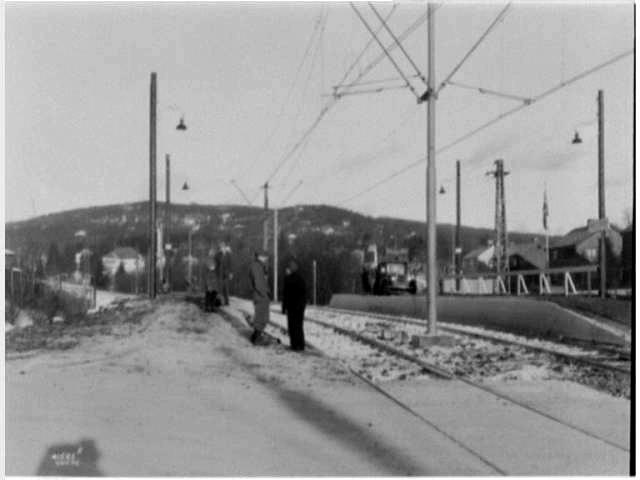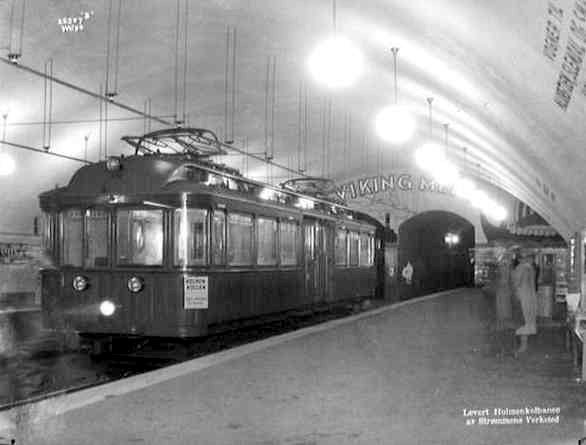|
Grini
Grini is a district in northeastern Bærum, Norway. Concentration camp The name Grini is best known from the concentration camp of the same name, but this camp lay further west and had no actual connection to the Grini area. History The name Grini is a variant of ''Granvin'' ( a placename used elsewhere), and stems from spruce trees in the area. The Old Norse form was Grǫnin. The farm Grini is known at least since 1348, when it was divided into a northern and a southern part. Both farms belonged to the Church of Norway, but the crown usurped the property following the Protestant Reformation. The dwelling house was erected in 1658, three years before the property was sold from the crown to a private person. Between the mid-seventeenth century and the mid-nineteenth century the property was owned by the Leuch, Anker and Wedel-Jarlsberg families. It was bought by Ole Ellefsen Gjedsø in 1854; he later became mayor of Bærum. Grini was the easternmost farm in Bærum municipality, ... [...More Info...] [...Related Items...] OR: [Wikipedia] [Google] [Baidu] |
Røa Line
The Røa Line () is a rapid transit line of the Oslo Metro, Norway, which runs from Majorstuen (station), Majorstuen in Oslo to Østerås (station), Østerås in Bærum. It serves neighborhoods such as Smestad, Oslo, Smestad, Hovseter, Huseby and Røa in northwestern Oslo, and Grini, Øvrevoll and Østerås in northeastern Bærum. The line is served by Line 2 of the metro, which connects to the city center via the Common Tunnel and onwards along the Furuset Line. The lowest part of the Røa Line, consisting of two stations, is shared with the Kolsås Line, and thus also served by Line 2 of the metro. The Røa Line is owned by Kollektivtransportproduksjon, and operated by Oslo T-banedrift on contract with the public transport agency Ruter. The first part of the line, originally a light rail, was from Majorstuen to Smestad (station), Smestad, and opened in 1912. It was built as a cooperation between the Municipality of Aker, Norway, Aker and the company Holmenkolbanen, and connected ... [...More Info...] [...Related Items...] OR: [Wikipedia] [Google] [Baidu] |
Grini (station)
Grini is a former metro station on the Røa Line of the Oslo Metro. The station was located between Ekraveien and Eiksmarka, and was opened when the Røa Line was extended into Bærum on 22 December 1948. It was the first station on the Røa Line located in Bærum; the line would later be extended to Lijordet (1951) and Østerås Østerås is a village in Akershus, Norway Norway, officially the Kingdom of Norway, is a Nordic countries, Nordic country located on the Scandinavian Peninsula in Northern Europe. The remote Arctic island of Jan Mayen and the archipelago ... (1972). Grini station was closed as a part of the Røa Line overhaul in 1995. References Oslo Metro stations in Bærum Disused Oslo Metro stations Railway stations in Norway opened in 1948 Railway stations in Norway closed in 1995 {{Oslo-metro-stub ... [...More Info...] [...Related Items...] OR: [Wikipedia] [Google] [Baidu] |
Ekraveien (station)
Ekraveien is the last Oslo Metro station on the Røa Line within Oslo's city limits. It is between the stations Røa and Eiksmarka. It was opened 22 December 1948 when the Røa Line was extended to Grini. Ekraveien itself is a road which runs north from the station to Bogstad Bogstad Manor (''Bogstad gård'') is a historic manor house and former estate located in the borough of Vestre Aker in Oslo, Norway. It is situated in the northwestern part of Oslo. Background Bogstad has its origin in a farm which was locat .... The neighborhood around the station is residential, consisting mostly of detached housing. References External links Oslo Metro stations in Oslo Railway stations in Norway opened in 1948 {{Oslo-metro-stub ... [...More Info...] [...Related Items...] OR: [Wikipedia] [Google] [Baidu] |
Eiksmarka (station)
Eiksmarka is a station on the Røa Line of the Oslo Metro. It is located between Ekraveien and Lijordet, 8.9 km from Stortinget. The station was opened in 1951 as part of the extension to Lijordet. After the closing of Grini in 1995, it is the first of three stations on the Røa Line within Bærum Bærum () is a list of municipalities of Norway, municipality in the Greater Oslo Region in Akershus County, Norway. It forms an affluent suburb of Oslo on the west coast of the city. Bærum is Norway's fifth largest municipality with a populatio ... municipality. The station serves northwestern Bærum, including Eiksmarka and Fossum; to the north of the station is the Eiksmarka school. The station was the site of a murder in 2002 when a 22-year-old Ethiopian woman was stabbed to death by her husband. References External links Oslo Metro stations in Bærum Railway stations in Norway opened in 1951 {{Oslo-metro-stub ... [...More Info...] [...Related Items...] OR: [Wikipedia] [Google] [Baidu] |
Lijordet (station)
Lijordet is a station on the Røa Line of the Oslo Metro. It is located between Østerås and Eiksmarka, 9.6 km from Stortinget. It is the second of three stations on the Røa Line within Bærum Bærum () is a list of municipalities of Norway, municipality in the Greater Oslo Region in Akershus County, Norway. It forms an affluent suburb of Oslo on the west coast of the city. Bærum is Norway's fifth largest municipality with a populatio ... municipality. The station was opened in 1951 when Røabanen was expanded from Grini to Lijordet. References External links Oslo Metro stations in Bærum Railway stations in Norway opened in 1951 {{Oslo-metro-stub ... [...More Info...] [...Related Items...] OR: [Wikipedia] [Google] [Baidu] |
German Occupation Of Norway
The occupation of Norway by Nazi Germany during the Second World War began on 9 April 1940 after Operation Weserübung. Conventional armed resistance to the German invasion ended on 10 June 1940, and Nazi Germany controlled Norway until the capitulation of German forces in Europe on 8 May 1945. Throughout this period, a pro-German government named '' Den nasjonale regjering'' ('the National Government') ruled Norway, while the Norwegian king Haakon VII and the prewar government escaped to London, where they formed a government in exile. Civil rule was effectively assumed by the Reichskommissariat Norwegen (Reich Commissariat of Norway), which acted in collaboration with the pro-German puppet government. This period of military occupation is, in Norway, referred to as the "war years", "occupation period" or simply "the war". Background Having maintained its neutrality during the First World War (1914–1918), Norwegian foreign and military policy since 1933 was largely inf ... [...More Info...] [...Related Items...] OR: [Wikipedia] [Google] [Baidu] |
Norwegian National Road 168
Norwegian National Road 168 () is a major route between Bærum and Oslo, Norway. It stretches from the industrial area of Rud, Bærum to the inner city of Oslo. It is connected with important roads like the European route E16 and the National Roads 150 ( Ring 3), 161 (Ring 2) and 162 ( Ring 1). The entire route is 20.6 km. Places to be found along the route are Bærums Verk, Øverland, Hosle, Østerås, Grini, Røa, Hovseter, Smestad, Vestre gravlund, Majorstuen and Uranienborg. It ends near the Royal Palace, Oslo. The road passes through both densely populated and rural areas. Due to the importance of this road and its many large intersections there is relatively heavy traffic during peak hours. A tunnel under Røa is considered. The road consists mainly of two lanes, but from Smestad to Majorstuen it has four lanes. At certain sections, the Røa Line runs parallel to the road. References * http://www.vegvesen.no/Vegprosjekter/rv168roatunnelen 168 Year 168 ... [...More Info...] [...Related Items...] OR: [Wikipedia] [Google] [Baidu] |
Bærum
Bærum () is a list of municipalities of Norway, municipality in the Greater Oslo Region in Akershus County, Norway. It forms an affluent suburb of Oslo on the west coast of the city. Bærum is Norway's fifth largest municipality with a population of 128,760 (2021). The administrative centre of the municipality is the list of towns and cities in Norway, town of Sandvika. Bærum was formannskapsdistrikt, established as a municipality on 1 January 1838. Bærum has the highest income per capita in Norway and the highest proportion of university-educated individuals. Bærum, particularly its eastern neighbourhoods bordering East End and West End of Oslo, West End Oslo, is one of Norway's priciest and most fashionable residential areas, leading Bærum residents to be frequently stereotyped as snobs in Norwegian popular culture. The municipality has been voted the best Norwegian place to live in considering governance and public services to citizens. Name The name (Old Norse: ''Berghei ... [...More Info...] [...Related Items...] OR: [Wikipedia] [Google] [Baidu] |
Volvat (station)
Volvat was a rapid transit station of the Oslo Metro's Røa Line and Kolsås Line. Situated in the neighborhood of Volvat in Vestre Aker borough of Oslo, Norway, it was the sole underground station on the western part of the metro. It was located from Stortinget. The station opened on 7 November 1912 at ground level, located at the level crossing with Sørkedalsveien. Due to increasing traffic, the line was placed in a culvert under the road in 1939. Trains along the Røa Line stopped calling at the station from 5 February 1995, since that line was upgraded to longer trains. The same happened with the Kolsås Line from 7 April 1997, after which the station was closed. The operated deemed the cost of upgrading the station not to be worth it. History Volvat took its name from pharmacist Harald Thaulow (1815–81), who owned the farm during his lifetime. The name is a slight simplification of his surname backwards. From the 1900s the area was regulated for housing, making it an ... [...More Info...] [...Related Items...] OR: [Wikipedia] [Google] [Baidu] |
Oslo Metro
The Oslo Metro ( or or simply ) is the rapid transit system of Oslo, Norway, operated by Sporveien T-banen on contract from the transit authority Ruter. The network consists of five lines that all run through the city centre, with a total length of , serving 101 stations of which 17 are underground or indoors. In addition to serving 14 out of the 15 boroughs of Oslo, two lines run to Kolsås and Østerås, in the neighbouring municipality of Bærum. In 2016, the system had an annual ridership of 118 million. The first rapid transit line, the Holmenkollen Line, opened in 1898, with the branch Røa Line opening in 1912. It became the first Nordic underground rapid transit system in 1928, when the underground line to Nationaltheatret was opened. After 1993 trains ran under the city between the eastern and western networks in the Common Tunnel, followed by the 2006 opening of the Ring Line. All the trains are operated with MX3000 stock. These replaced the older T1000 stock ... [...More Info...] [...Related Items...] OR: [Wikipedia] [Google] [Baidu] |





